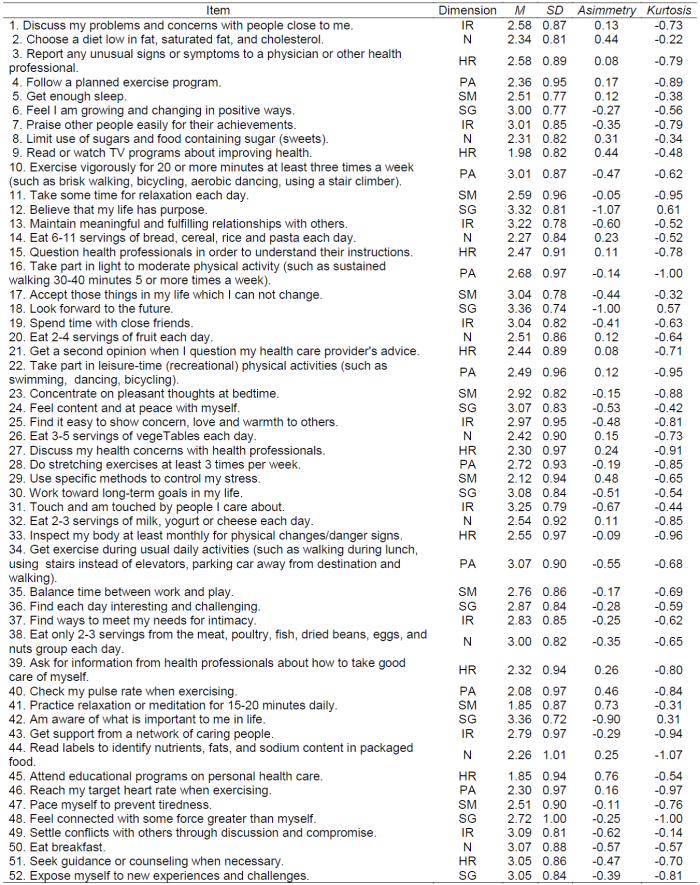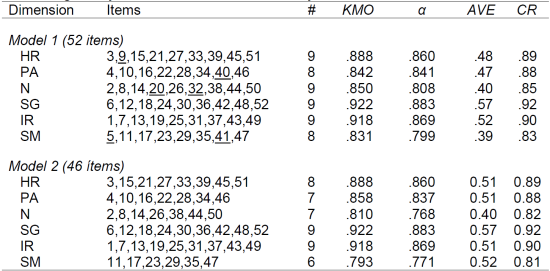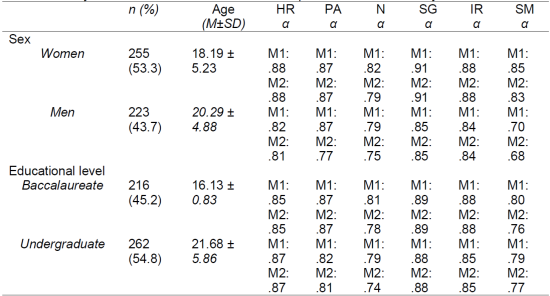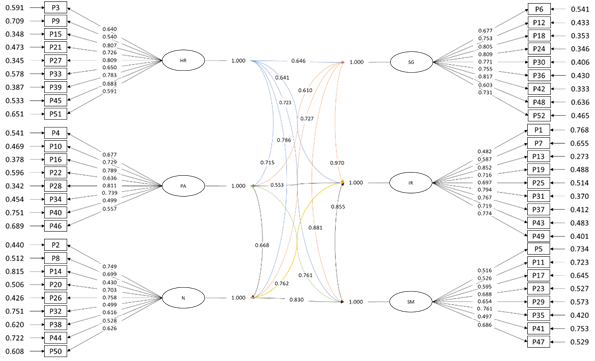Meu SciELO
Serviços Personalizados
Journal
Artigo
Indicadores
-
 Citado por SciELO
Citado por SciELO -
 Acessos
Acessos
Links relacionados
-
 Citado por Google
Citado por Google -
 Similares em
SciELO
Similares em
SciELO -
 Similares em Google
Similares em Google
Compartilhar
Enfermería Global
versão On-line ISSN 1695-6141
Enferm. glob. vol.21 no.66 Murcia Abr. 2022 Epub 02-Maio-2022
https://dx.doi.org/10.6018/eglobal.490521
Originals
Psychometric properties of the Spanish version of the Health-Promoting Lifestyle Profile-II instrument in Mexican university students
1 Universidad Autónoma de Nuevo León. México. maria.enriquezryn@uanl.edu.mx
2 Universidad de Guadalajara. México.
3 Universidad Estatal de Sonora. México.
Introduction:
The Health-Promoting Lifestyle Profile-II instrument was developed in English and in Spanish to examine health-promoting lifestyle profiles. Several reports question the validity of its Spanish version; it is thought that the translation employed requires changes according to the cultural context in which it is intended to be used. The proposal was to evaluate the psychometric properties of the six dimensions proposed by the original version of the instrument in Mexican university students.
Method:
Ex post facto design with 478 students from a public university in northeastern Mexico. The analysis was performed in LISREL 8.1 and in SPSS 21.0. A psychometric analysis was performed of the six dimensions with factor homogeneity, validity, and reliability indices in two models.
Results:
Descriptive data and results of the factor analysis are presented with a moderate fit model and a distribution that explains 49.93% of the variance. The 52-item version presented low convergent and discriminant validity values; by removing six items, these values reached normalization for five of the six dimensions. In opposition to that, reliability of the scores was good.
Conclusions:
In this sample from the Mexican context, some problems of the Spanish version's factor solution are confirmed with a model that presents moderate fit given the six-dimension structure. However, the predicted structure shows accepTable reliability values. In the experts' opinion, the six-dimension structure seems to be the most adequate to be used in Mexican university students.
Keywords: Lifestyle; scale; validation study; health profile; health behavior; interpersonal relations
INTRODUCTION
The World Health Organization1 states that “Health promotion allows people to better control their own health” and describes that it has three essential components: good health governance, education in health and healthy cities. Although there has been significant progress in relation to health in Latin America, limited performance in the social basis of the health-disease process has been reported. Many of the health promotion initiatives implemented and developed at the individual level did not yield the expected results; therefore, the need to devise health promotion strategies that consider a social, community, political and comprehensive approach is justified, allowing for egalitarian access to effective responses in health2. This can only be achieved through specific knowledge of the behaviors and priorities recognized in each context; hence the importance of analyzing the health-promoting behaviors recognized in the population.
Nola Pender, a Nursing theorist, states that health-promoting behaviors are manifested through actions targeted at achieving positive health results and that they include, for example: healthy eating habits, sleeping well, performing physical activity, and avoiding habits that are harmful for health, among other behaviors. When the health-promoting behaviors are incorporated into a lifestyle there are improvements in health, functional capacity is enhanced and, therefore, there is a contribution to developing better quality of life3. With the development of the Health Promotion Model and multiple instruments to assess related behaviors, Nola Pender has set the basis for the health personnel to strengthen the development of action strategies which consider the influence of individual cognition, characteristics, and experiences on the performance of health-promoting behaviors.
The Health-Promoting Lifestyle Profile-II(HPLP-II) instrument was developed to examine the perception of control over health4; the original version in American English consists of 52 items grouped into six dimensions, namely: Health responsibility, Physical activity, Nutrition, Spiritual growth, Interpersonal relationships, and Stress management. The authors of the instrument presented a validation of the Spanish version applied to the Hispanic population5,6; however, many reports question its validity, indicating the possibility of the translation employed requiring changes according to the cultural context in which it is intended to be used. In the United States, it was reported that the influence of cultural factors might be affecting validity in the Hispanic male population7; whereas, in Spain, two studies have been proposed in which a number of items have been removed or the factor structure of the original version of the instrument has been modified8,9 and, in a sample from Central America, the need to review the instrument's convergent validity was also reported10. Given the apparent content validity presented by each of the six dimensions of the Spanish version (which can be corroborated from the perspective of several experts in the Nursing area) and the need to evaluate the health-promoting lifestyles' profiles, it was proposed to assess the psychometric properties of the six dimensions with 52 items of the Spanish version of HPLP-II in a sample comprised by university students from the Mexican context.
MATERIAL AND METHOD
An instrumental research study with an ex post facto and cross-sectional design to evaluate the psychometric properties of the Spanish version of an instrument11.
Participants
The participants were 478 students from a public university in northeastern Mexico. Students currently enrolled in associate and undergraduate degree courses who accepted to voluntarily participate in the study were included; the data of those participants aged over 30 years old were removed. Non-probabilistic sample was used, considering fourteen sports or arts schools.
Instrument
The Spanish version of HPLP-II4 consisting of 52 items is assessed through a Likert-type scale with answer options that include four frequency levels: never, sometimes, almost always and always. Higher scores indicate higher levels of health-promoting lifestyles. The dimensions that comprise the original instrument are as follows: Health responsibility (9 items); Physical activity (8 items); Nutrition (9 Items); Spiritual growth (9 items); Interpersonal relationships (9 items); and Stress management (8 items).
Procedure
The project was registered at the Research Coordination Office of an Educational Institution (REPRIN-FOD-71). A digital survey was sent through the institutional e-mail service to students affiliated to any sports or arts intra-university school with courses encompassing the mid higher (associate) and higher (only undergraduate) levels. Voluntary and anonymous participation was requested. In a six-week period, a response rate above 60% was considered.
Statistical analysis
The analyses were performed in the LISREL 8.1 and SPSS 21.0 software programs. It was not necessary to remove cases due to missing data or to use imputation methods, as a full answer matrix was employed since collection. As the original version of the instrument considered the adaptation to Spanish, the dimensions proposed by the original authors were used and the confirmatory factor analysis (theoretical model) was performed immediately after that. Content validity was reviewed by showing the psychometric properties of the two structures evaluated to four experts with the Delphi Method. A psychometric analysis with factor homogeneity, validity (Mean Extracted Variance [MEV] and Composite Reliability [CR]) and reliability (internal consistency with Cronbach's alpha) indices was performed. The results of the Kaiser-Meyer-Olkin (KMO) index are included and, for the validity of each factor, MEV was assessed considering that MEV values > .50 show convergent validity12; in addition, it was estimated that CR should consider values above .7013. The descriptive analysis is presented with central tendency and dispersion measures of the items, in the order in which they appear in the instrument. In addition, a second model was evaluated, which contemplated the possibility of removing items based on low values in the standard coefficients (model 2). To determine goodness of fit of the models evaluated, a significant chi-square/degrees of freedom value was considered with values from 2 to 5 and the following indices: Comparative Fit Index (CFI) ≥ .95, Incremental Fit Index (IFI) ≥ .95, Non-Normed Fit Index (NNFI) ≥ .95 and Root Mean Square Error of Approximation (RMSEA) < .08 14 according to the recommendations set forth in the Editorial Guide for the submission of validation papers of tests in Health and Social Sciences15.
RESULTS
Two hundred and fifty-five of the participants are women (53.3%), 45.2% (n= 216) attends the university mid-higher level and the remaining 54.8% belongs to the higher undergraduate level. The mean age was 19.17 years old (SD= 5.17). 12.8% (n= 61) reported not practicing any type of extracurricular activity at the time they answered the survey. The instrument's conFiguration is presented with central tendency and dispersion measures (Table 1).
Table 1. Descriptive data of the 52 ítems of the instrument Health Promoting Lifestyle Profile-II in Mexican university students

Note. HS = Health responsibility; PA = Physical activity; N = Nutrition; SG = Spiritual growth; IR = Interpersonal relationships; SM= Stress management. n = 478.
The six-dimension model with the 52 items from the original version presents accepTable fit according to four of the five criteria considered with a model that explains 49.93% of the variance. The RMSEA value presents moderate fit in both models evaluated (Table 2).
Table 2. Factor analyzes of the six dimensions of the Health Promoting Lifestyle Profile-II Instrument in Mexican university students

Note. In model 2 the items 5,9, 20, 32, 40, 41 were eliminated. n = 478.
Table 3 presents the validity and reliability values of the scores with data that corroborate very good levels. Only the “Spiritual growth” and “Interpersonal relationships” dimensions presented adequate convergent and discriminant validity values.
In theory, it is sought that the construct explains more than half of the variance of the indicators which comprise the factor (MEV> .50). In the full 52-item survey, this measure was good for the “Spiritual growth” and “interpersonal relationships” dimensions; but it presented borderline values for the “Health responsibility” and “Physical activity” dimensions (MEV= 0.48 and 0.47, respectively) and low values were observed for the “Nutrition” and “Stress management” dimensions (MEV= .40 and .39), which suggest that the model does not explain much of the variance of these indicators in these two cases. Based on low factor saturation of the standard coefficients (< .3), it was decided to remove items one by one until evaluating the affectation of other indicators. In model 2, the variance values achieved normalization in five of the six factors. The “Nutrition” dimension remained with low variance values.
Table 4 describes some characteristics of the sample and the reliability of the dimensions of the original version (model 1) and with six items removed (model 2). As can be seen, gender and schooling level do not seem to affect reliability of the structure with 52 or 46 items (models 1 and 2).
Table 3. Reliability and validity of the dimensions of the Spanish version of the Health Promoting Lifestyle Profile-II in Mexican university students

Nota. α = Cronbach's alpha coefficient; Sampling adequacy measure Kaiser-Meyer-Olkin; AVE = Average Variance Extracted; CR = Composite reliability; HR = Heatlh responsibility; PA = Physical activity; N = Nutrition; SG = Spiritual growth; IR = Interpersonal relationships; SM = Stress management. n = 478.
Table 4. Characteristics of the sample and reliability of the Health Promoting Lifestyle Profile-2 dimensions by sex and educational level in the sample of Mexican university students.

Note: HR = Heatlh responsibility; PA = Physical activity; N = Nutrition; SG = Spiritual growth; IR = Interpersonal relationships; SM = Stress management; α = Cronbach's alpha coefficient; M1 = Model 1; M2 = Model 2.
Finally, the factor structure of the Spanish version evaluated in this sample of Mexican university students is presented. Figure 1 describes the detail of the factor loads and the errors by item and by dimension.
DISCUSSION
The evaluation of the psychometric properties of the HPLP-II instrument for the assessment of lifestyles in the university population is useful to compare validity and reliability of this indicator. In Psychology, factor analysis proposes a statistical model that represents the relationships between variables; in this type of studies, it is applied to assess the structure of a test from the scores obtained in its items; however, the main methodological problems encountered in the face of this situation are attributed to decision that the researcher must make in the estimation, model's fit and rotation stages16. In this sample from the Mexican context, some problems have been corroborated in the Spanish version of this scale regarding the factor solution that suggests a moderate fit given the six-dimension structure; however, following the opinion of experts in the context, a consensus has been reached in relation to the pertinence of the original model. Based on the above, it is not considered that there is any reason that justifies the proposal of implementing substantial changes to the six-dimension structure of the instrument.
The usefulness of the indicators of non-observable variables such as the health-promoting behaviors depends on validity and reliability. As already presented, language and context affect the measuring instruments, reason why it becomes pertinent to evaluate the psychometric properties before establishing any inferences from them. In this context, the factor and reliability review suggest that the six-dimension instrument can be applied either with 52 or with 46 items. This evaluation confirms the dimensions hypothesized from the original version of the theoretical model, which include the following: Health responsibility (9 or 8 items); Physical activity (8 or 7 items); Nutrition (9 or 7 Items); Spiritual growth (9 items); Interpersonal relationships (9 items) and Stress management (8 or 6 items). Given the possibility of affecting content validity when removing items, it was considered that the factor solution of the second model presented is sufficient for the purpose of discriminant validity and for maintaining reliability of the measurement of the latent variables of interest.
Low MEV values were observed in model 1, which corresponds to the original structure proposed by the authors of the instrument, which suggests deficits in relation to discriminant validity. When removing six items, these values improved in five of the six dimensions. The “Nutrition” dimension did not present adequate discriminant validity; however, when performing the content analysis of the instruments' items, the pertinence of such dimension is evident. The problem of the “Nutrition” dimension is in line with the findings of Spanish version by Serrano-Fernández et al. 9 and with the report by Kamali et al. 16 in Kurdish health care providers. Given this situation, Serrano-Fernández et al. 9 sought to improve the factor solution by removing two items, in addition to moving an item to the “Health responsibility” dimension; and, on the other hand, Kamali et al. 17 limited themselves to arguing that items 44 (“I read labels to identify nutrients, fats, and sodium content in packaged food”) and 50 (“I have breakfast and eat later”) showed a low correlation in the factor for not being relevant in the Kurdish culture, which consequently derived in low reliability in the dimension (Cronbach's Alpha= .622). The participants' nutritional culture might be interfering with the results of this analysis. This can be explained if we consider that variance depends on the length of the test and the heterogeneity of the scores, in addition to the specific characteristics of the study sample13)(18)(19.
The six-factor structure is in consonance with the findings by other researchers who have reported the validity of the questionnaire in different languages, both with 44 and with 52 items5)(8)(17)(20)(21)(22)(23)(24)(25. However, there are other solutions such the one recently proposed by Rathnakyake et al. 26 for Sri Lanka, with seven factors, and the four-factor version for Kenia by Olutende et al. 27.
In opposition to the findings of the analysis purpose in our Mexican sample is the publication by the researchers who set to undertake a full adaptation of the instrument into Spanish with the findings of a sample comprised by Spanish workers9. Due to the length of the instrument, the analysis of the factor structure might come out with a different proposal than the instrument's goal; on the other hand, voluntary omission by the researchers regarding the recommendation to employ the same number of categories as in the original version when seeking to adapt a test to another language seems to respond more to the intention of generating a new instrument than to evaluate the properties of a proposal. Given the heterogeneity of criteria for the validation of instruments, the goal of the Spanish proposal turns out to be valid; however, it is not in agreement with the criterion applied in this project towards assessing the validity of the original structure and proposal of an instrument that, in the opinion of subject matter experts, is appropriate for its measuring purpose. The four-factor structure proposed by the researchers was reviewed and it was determined that its application would be questionable in this Mexican context.
The validity and reliability data of this report correspond to application of the instrument in a population with similar characteristics to those of the sample of the study from northeastern Mexico. The factor solution presented is limited to assessing the usefulness of the six-dimension model offered by the original version of the HPLP-II instrument; however, the objective of this project was not to determine the best factor solution of the instrument considering its previously reported usefulness in multiple languages. It is recommended that, when using the Spanish version of the HPLP-II instrument, in addition to reviewing the traditional reliability and validity values (Cronbach's alpha and KMO), the researchers report the discriminant validity and composite reliability estimations of the dimensions considered. With this proposal, two useful models are offered which might be employed in case of identifying absence of discriminant validity when using the full 52-item structure.
CONCLUSIONS
The psychometric properties suggest that the model of the HPLP-II instrument with six dimensions shows partially good fit properties. Other indicators suggest that it is reliable, valid, and adequate to be used in Spanish with a six-factor structure with the possibility of employing both 52 and 46 items, according to the strictness of criteria that the researchers choose to adopt during its use.
REFERENCIAS
1. Organización Mundial de la Salud ¿Qué es la promoción de la salud? Sitio de la Organización Mundial de la Salud. 2016. Disponible en https://www.who.int/features/qa/health-promotion/es/ [ Links ]
2. Coronel-Carbo J, Marzo-Páez N. La promoción de la salud: evolución y retos en América Latina. MEDISAN. 2017; 21(7): 926-932. Disponible en: http://scielo.sld.cu/scielo.php?script=sci_arttext&pid=S1029-30192017000700018&lng=es. [ Links ]
3. Pender NJ, Murdaugh CL, Parsons MA. Health promotion in nursing practice. 6a ed. Nueva Jersey: Pearson;2011 [ Links ]
4. Walker SN, Sechrist KR, Pender NJ. Health Promotion Model - Instruments to Measure Health Promoting Lifestyle: Health-promoting Lifestyle Profile II [HPLP II] (Adult version). 1995. Disponible en: https://deepblue.lib.umich.edu/bitstream/handle/2027.42/85349/HPLP_II-Dimensions.pdf?sequence=2 [ Links ]
5. Hulme PA, Walker SN, Effle KJ, Jorgensen L, McGowan MG, Nelson JD, Pratt EN. Health-promoting lifestyle behaviors of Spanish-speaking Hispanic adults. J Transcult Nurs. 2003; 14(3): 244-254. Disponible en: https://dx.doi.org/10.1177/1043659603014003011 [ Links ]
6. Walker SN, Hill-Polerecky DM. Psychometric evaluation of the Health-Promoting Lifestyle Profile II. 1996: Manuscrito sin publicar. Disponible en: https://deepblue.lib.umich.edu/bitstream/handle/2027.42/85349/HPLP_II-Dimensions.pdf?sequen-ce=2 [ Links ]
7. Mullins IL, O'Day T, Kan TY. Validation of the Health-Promoting Lifestyle Profile II for Hispanic male truck drivers in the Southwest. Clin Nurs Res. 2013; 22(3): 375-94. Disponible en: https://dx.doi.org/10.1177/1054773812459072 [ Links ]
8. Pérez-Fortis A, Ulla Díez SM, Padilla JL. Psychometric properties of the Spanish version of the Health-Promoting Lifestyle Profile II. Res Nurs Health. 2012; 35(3): 301-313. Disponible en: https://dx.doi.org/10.1002/nur.21470 [ Links ]
9. Serrano-Fernández MJ, Boada-Grau J, Vigil-Colet A, Gil-Ripoll C. Adaptación española de la escala HPLP-II con una muestra de empleados. Universitas Psychologica. 2016: 15(4). Disponible en: https://doi.org/10.11144/Javeriana.upsy15-4.aeem [ Links ]
10. Kuster AE, Fong CM. Further psychometric evaluation of the Spanish language health-promoting lifestyle profile. Nurs Res. 1993; 42(5): 266-269. [ Links ]
11. Ato M, López JJ, Benavente A. Un sistema de clasificación de los diseños de investigación en psicología. Anal. Psicol.2013; 29(3): 1038-1059. Disponible en: https://dx.doi.org/10.6018/analesps.29.3.178511. [ Links ]
12. Fornell C, Larcker DF. Evaluating Structural Equation Models with Unobservable Variables and Measurement Error. J Market Res.1981; 18(1): 39-50. Disponible en: https://dx.doi.org/10.1177/002224378101800104 [ Links ]
13. Rubia JM. Revisión de los criterios para validez convergente estimada a través de la Varianza Media Extraída. Psychologia. Avances de la Disciplina. 2019: 13(2); 25-41. Disponible en: https://doi.org/10.21500/19002386.4119. [ Links ]
14. Arias Martínez, B. Desarrollo de un ejemplo de análisis factorial confirmatorio con LISREL, AMOS y SAS. Publicaciones del INICO. 2008;75-120. [ Links ]
15. Guía editorial para la presentación de trabajos de validación de tests en Ciencias Sociales y de Salud. s. f. Disponible en: https://www.um.es/analesps/informes/GuiaValidacionTestsAnalesps2013.pdf [ Links ]
16. Ferrando PJ, Anguiano-Carrasco C. El análisis factorial como técnica de investigación en psicología. Papeles del psicológo. 2010; 31(1): 18-33. Disponible en: https://www.redalyc.org/articulo.oa?id=77812441003 [ Links ]
17. Kamali AS, Sadeghi R, Tol A, Yaseri M. Reliability and Validity of Kurdish Language Version of Health Promoting Lifestyle Profile II among Kurdish Healthcare Providers Kurdish Version of HPLP-II. Arch Iran Med. 2016; 19(12): 824-831. [ Links ]
18. Farrell, A. M. Insufficient discriminant validity: A comment on Bove, Pervan, Beatty and Shiu (2009). J Bus Res.2010;63(3):324-327. Disponible en: https://doi.org/10.1016/j.jbusres.2009.05.003 [ Links ]
19. McDonald, R. P. Test theory: A unified treatment. 1a ed. Nueva York: Psychology Press; 1999 [ Links ]
20. Aqtash S, Van Servellen G. Determinants of health-promoting lifestyle behaviors among Arab immigrants from the region of the Levant. Res Nurs Health. 2013; 36(5): 466-477. Disponible en: https://dx.doi.org/10.1002/nur.21555 [ Links ]
21. Kuan G, Kueh YC, Abdullah N, Tai ELM. Psychometric properties of the health-promoting lifestyle profile II: cross-cultural validation of the Malay language version. BMC Public Health. 2019; 19(1): 751. Disponible en: https://dx.doi.org/10.1186/s12889-019-7109-2 [ Links ]
22. Pinar R, Celik R, Bahcecik N. Reliability and construct validity of the Health-Promoting Lifestyle Profile II in an adult Turkish population. Nurs Res. 2009; 58(3): 184-193. Disponible en: https://dx.doi.org/10.1097/NNR.0b013e31819a8248 [ Links ]
23. Sousa P, Gaspar P, Vaz DC, Gonzaga S, Dixe MA. Measuring health-promoting behaviors: cross-cultural validation of the Health-Promoting Lifestyle Profile-II. Int J Nurs Knowl. 2015; 26(2): 54-61. Disponible en: https://dx.doi.org/10.1111/2047-3095.12065 [ Links ]
24. Tanjani PT, Azadbakht M, Garmaroudi G, Sahaf R, Fekrizadeh Z. Validity and Reliability of Health Promoting Lifestyle Profile II in the Iranian Elderly. Int J Prev Med. 2016; 7:74. Published 2016 May 19. Disponible en: https://dx.doi.org/10.4103/2008-7802.182731 [ Links ]
25. Wei CN, Yonemitsu H, Harada K, Miyakita T, Omori S, Miyabayashi T, Ueda A. Development of a Japanese version of the Health Promoting Lifestyle Profile II (HPLP II). Japanese Journal of Hygiene. 2000: 54(4); 597-606. Disponible en: https://doi.org/10.1265/jjh.54.597 [ Links ]
26. Rathnayake N, Alwis G, Lenora J, Lekamwasam S. Applicability of health promoting lifestyle profile-II for postmenopausal women in Sri Lanka; a validation study. Health Qual Life Outcomes. 2020; 18(1): 122. Disponible en: https://dx.doi.org/10.1186/s12955-020-01371-7 [ Links ]
27. Olutende OM, Wamukoya EK, Wanzala MN. Validation of a Four-Factor Measurement Model of the Health Promoting Lifestyle Profile-II: a Confirmatory Study with Kenyan Undergraduate Students. Saudi J Nurs Health Care. 2019: 2(12); 396-406. Disponible en: https://doi.org/10.36348/sjnhc.2019.v02i12.001 [ Links ]
Received: August 29, 2021; Accepted: January 03, 2022











 texto em
texto em 



